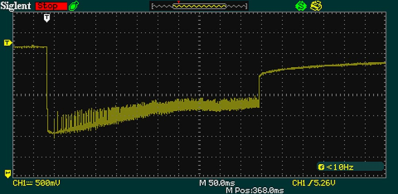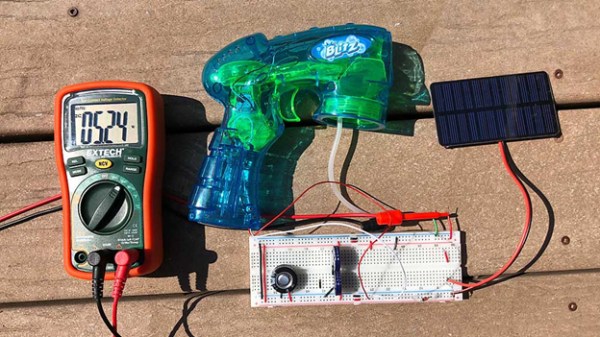[Fmilburn] was having fun with his grandkids, playing around with a small Radio Shack solar panel, some supercapacitors and a Zener diode when the kids eventually moved on to blowing bubbles with their grandmother. To regain their interest he got an inexpensive battery powered, soap Bubble Blaster and converted it to run on the solar panel and supercapacitors instead.
 His write-up is a pretty fun read, walking through his process, including an oscilloscope measurement showing how the capacitors’ voltage drops from 5.26 V to 3.5 V when the trigger is pressed, and interestingly, slowly recovers until it’s released a second later, when it then rises back to 4.5 V. He’s even included how he worked out of the panel’s maximum power point (MPP), which is what he was doing when the kids were first lured away to blow soap bubbles. But we’re sure Hackaday readers aren’t as easily distracted.
His write-up is a pretty fun read, walking through his process, including an oscilloscope measurement showing how the capacitors’ voltage drops from 5.26 V to 3.5 V when the trigger is pressed, and interestingly, slowly recovers until it’s released a second later, when it then rises back to 4.5 V. He’s even included how he worked out of the panel’s maximum power point (MPP), which is what he was doing when the kids were first lured away to blow soap bubbles. But we’re sure Hackaday readers aren’t as easily distracted.
The resulting Solar Powered Bubble Blaster works quite well. At a starting voltage of 5.23 V, it runs for 15 seconds and then takes only a minute to recharge. Charged batteries would have had a longer runtime but take longer to recharge, an important point when trying to keep kids interested. See it in action in the video below.
Want to instead fill your neighborhood with soap bubbles? Check out this 14,000 BPM (Bubbles Per Minute) 3D printed soap bubble machine. Or maybe something more relaxed is your speed.
Continue reading “Hacking A Solar Bubble Blaster With Grandkids”













